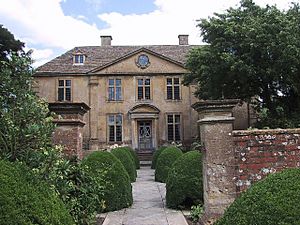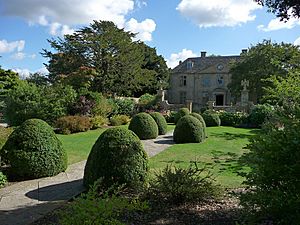Tintinhull Garden facts for kids
Quick facts for kids Tintinhull House and Garden |
|
|---|---|

The gate piers and path leading to the front of the house.
|
|
| Location | Tintinhull, Somerset, England |
| Built | 17th century |
|
Listed Building – Grade I
|
|
| Designated | 19 April 1961 |
| Reference no. | 1265231 |
| Type | Grade II |
| Designated | 1 June 1984 |
| Reference no. | 1001156 |
| Lua error in Module:Location_map at line 420: attempt to index field 'wikibase' (a nil value). | |
Tintinhull Garden is a beautiful place to visit in Tintinhull, near Yeovil in Somerset, England. It's a special garden from the 20th century, designed in the Arts and Crafts style. This lovely garden surrounds a house that is even older, built in the 17th century.
The whole property is now looked after by the National Trust. Lots of people, about 25,000 each year, come to explore its beauty. The house began as a small farmhouse in 1630. It was made much bigger in the 1700s to look more like it does today. The Napper family owned the house for many years. In 1954, it was given to the National Trust. The garden's design was inspired by the famous Hidcote Manor Garden. A talented gardener named Phyllis Reiss first created it, and later, Penelope Hobhouse helped it grow even more.
Discover Tintinhull House
The main part of Tintinhull House was built in 1630. It was made from a special local stone called Hamstone. Around 1722, the house was changed and made larger. The front of the house, facing west, was added at this time.
The Napper family owned the house for a long time. They got the land after the monasteries were closed down in England. The Nappers also owned another important building nearby called Tintinhull Court. The house stayed in their family until after 1814.
Later, the house had several different owners. In 1933, Phyllis Reiss and her husband, Captain F.E. Reiss, bought it. The house has some interesting paintings from the National Trust's collection. One painting shows the front of the house and was created by John S. Goodall.
Tintinhull House is a very important historical building. It is listed as a Grade I building, which means it's of exceptional interest. You can even book the house for a holiday through the National Trust!
Explore Tintinhull Garden
The garden at Tintinhull is designed like a series of outdoor "rooms." These rooms are separated by walls and tall hedges.
The garden's layout started to take shape in the early 1900s. Dr. Price, an earlier owner, added paths made of triangular and diamond-shaped stones. In the 1920s, the round, ornamental shapes of box plants were planted.
The garden really started to become what it is today in 1933. This is when Phyllis Reiss began to expand and plant it. She designed it in the Arts and Crafts style, similar to the famous Hidcote Manor Garden. The garden is about 1.5 acres in size. Its different "rooms" are divided by Yew hedges and walls. Some of these areas include Eagle Court, the Middle Garden, the Fountain Garden, and the Pool Garden. The Pool Garden was once a tennis court!
In 1954, Phyllis Reiss gave the house and garden to the National Trust. However, she continued to live there and care for the garden until she passed away in 1961. After her, the National Trust rented the house to different people. One famous tenant was Penelope Hobhouse, a well-known garden designer and writer. She lived there from 1980 to 1993.
The gardens are officially recognized on the National Register of Historic Parks and Gardens. They feature small pools and a lovely azalea garden, making them a wonderful place to visit.


